Quote:
We do hereby proclaim and declare solemnly in the name and by authority of the people of these Philippine Islands, that they are and have the right to be free and independent; that they have ceased to have any allegiance to the Crown of Spain; that all political ties between them are and should be completely severed and annulled; and that, like other free and independent States, they enjoy the full power to make War and Peace, conclude commercial treaties, enter into alliances, regulate commerce, and do all other acts and things which an Independent State has a right to do.
Source:
Ambrosio Rianzares Bautista (1898): Declaration of Independence.
Author Bio:
From the Declaration of Independence of the Philippines.
Context:
 The Philippines was a Spanish colony from 1571 until, as an outcome of anti-colonial liberation struggle, it declared independence in 1898. At the time, however, the USA wanted to incorporate the islands, and a fifth of the population lost their lives in the ensuing Philippine-American War of 1899 to 1902. The islands then became a US colony until 1942 when they were occupied by Japanese troops. The left-wing anti-Japanese People's Liberation Army was then formed, a partisan movement made up of 30,000 fighters and 70,000 reservists. They collaborated with the US against the Japanese, but opposed US colonial rule. According to writer Ricardo Trota Jose, 80% of Filippin@s were in the resistance or supported it: ‘One million Filipinos fought in various guerrilla movements’ (RJB & recherche international 2008: 132). Although the Philippines gained independence in 1946, a US-friendly government was then installed. It was only in 1990, under President Corazon Aquino, that the resistance fighters were finally recognised as such (ibid.: 100f.).
The Philippines was a Spanish colony from 1571 until, as an outcome of anti-colonial liberation struggle, it declared independence in 1898. At the time, however, the USA wanted to incorporate the islands, and a fifth of the population lost their lives in the ensuing Philippine-American War of 1899 to 1902. The islands then became a US colony until 1942 when they were occupied by Japanese troops. The left-wing anti-Japanese People's Liberation Army was then formed, a partisan movement made up of 30,000 fighters and 70,000 reservists. They collaborated with the US against the Japanese, but opposed US colonial rule. According to writer Ricardo Trota Jose, 80% of Filippin@s were in the resistance or supported it: ‘One million Filipinos fought in various guerrilla movements’ (RJB & recherche international 2008: 132). Although the Philippines gained independence in 1946, a US-friendly government was then installed. It was only in 1990, under President Corazon Aquino, that the resistance fighters were finally recognised as such (ibid.: 100f.).Further Reading:
*Rheinisches JournalistInnenbüro & recherche international (2008): Die Dritte Welt im Zweiten Weltkrieg. Unterrichtsmaterialien zu einem vergessenen Kapitel der Geschichte. Köln.
Year:
1898